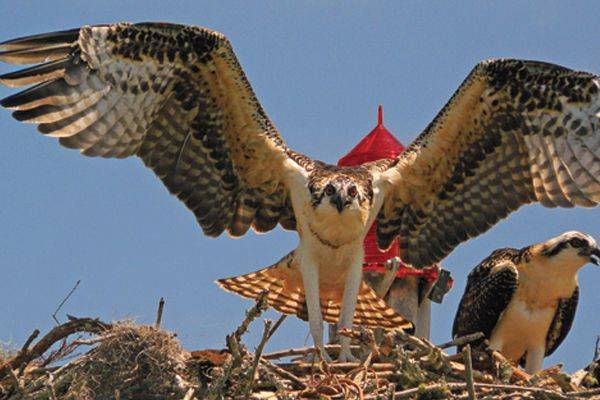[dropcap]B[/dropcap]y the time y’all read this it will be May, and it will be hot and humid with thunderstorms every afternoon, and winter will be nothing but a distant memory. But right at this moment, as the days get longer and the upcoming tax chores loom ever-larger, the seemingly-sudden transitions from winter to warmth are welcome indeed. And when the waters get warm the fishing gets hot, so get those rods & reels ready!
It all seemed to happen in about a 3-day span last week. When the torrential rains of early April finally let up, I headed out for a Sunday cruise. Along the lower Apalachicola River, swollen with runoff from the storms, the bare hardwoods of winter had leafed out in reds & yellows that looked more like autumn. Another week and that would all be solid green. Visits to my favorite osprey nests showed that the familiar black-and-white momma birds have taken up residence on the big piles of sticks they call home, and they are quick to howl their displeasure when I try to get a close look. Then, after running about five miles up the River near the junction with the St Marks, I was treated to my first 2014 sightings of swallow-tailed kites, soaring so gracefully over and through the treetops, then swooping low over the river in pursuit of flying food. Gators were much in evidence, too, as they came out onto fallen trees to bask in the springtime sunshine.

I cruised back down the River and out to Apalachicola Bay, and watched a crabber working his traps in Two Mile Channel. Those traps had been gone all winter, but the crabs have emerged from the mud, and so the traps have emerged from storage, and the man who works them is back out on the water. At each stop he was assisted by a flock of pelicans, who have re-discovered the easy meals of leftover crab bait that are available as he empties and re-baits his traps.
A few minutes, and another treat flew by: Black Skimmers, seemingly perusing the menu as they cruised past only a few inches off the water’s surface. Skimmers spend the winter elsewhere, but they breed & nest nearby. They will work this channel in groups of a dozen or more every evening once the young mouths are ready to feed. They wouldn’t be here if it weren’t for the food, which means the baitfish must be here too, right? After stopping and allowing the boat & wake to settle, an investigation of the shallows confirmed the hypothesis: big clouds of hundreds, maybe thousands of tiny fish were everywhere. Too small to catch & identify, but mullet would be a good guess. That’s good news for us, too, as they’ll soon be big enough to capture in a cast net and impale on a hook.
If the baby mullet are in the channel, I presume that adults aren’t far away. It only took a few minutes to confirm that theory, too, as I could see white mullet jumping out of the water in every direction. Soon the piscatorial predators will be here to chase them, and we can start chasing the predators.
I could go on — for instance, about the increasing numbers of dead snakes & live turtles I see while roaming the back roads on a bicycle — but it’s perfectly clear that spring is finally here.
For anglers, spring means that the good times are ready to roll. Bream and bass are either on the beds or will be very soon, as will the other freshwater springtime spawners. Baitfish of all kinds — mullet, menhaden, anchovies, herring — will be increasing in numbers, and in availability. Other kinds of live bait, from crawfish to crickets to worms, will be easier to find. Speckled trout, redfish, and flounder will be leaving their deep winter warm spots for their shallower warm-weather feeding grounds. By the time you read this, serious inshore angling should be in full swing.
For the Apalachicola River and Bay, spring means that the most important season of “primary productivity” is underway. This refers to the bottom of the food chain, where microbes and plants convert sunlight and nutrients into the edible matter that sustains all of the critters mentioned above. Fishing conditions next fall depend in significant ways on the level of productivity in the spring, which in turn depends on the amount of water in the river. When the vernal rains come and the river is high and the swamps are flooded, Mother Nature throws her springtime switch and the system comes to life. So every spring is a waiting and guessing game, as we hope that the multi-year droughts we’ve recently experienced will not return.
Good news: this spring, the rains have come relentlessly. It feels like the city of Apalachicola is about to wash off into the bay! River flow measured at Blounstown recently peaked at a level which is about five times normal river flow, and is predicted to be at flood stage or higher for another week. The river is big, fast, and very wide right now, with more water in the swamps than in the channel. Nature’s feeding cycle is in good shape! And as those waters eventually drain back out of the swamps in late spring and summer, they’ll carry lots of food to the lower river and bay for our favorite baitfish and gamefish.
And of course, those nutrients will sustain our favorite non-game species — oysters, shrimp, crabs, clams — that the bay provides for those days when the big fish don’t bite. One way or another, by hook or by checkbook, we should all eat well next fall.



